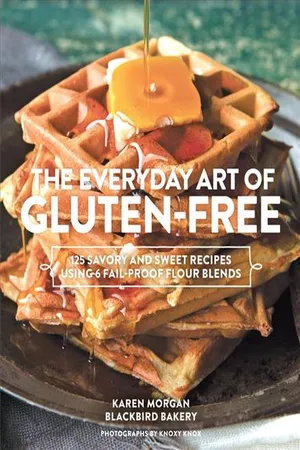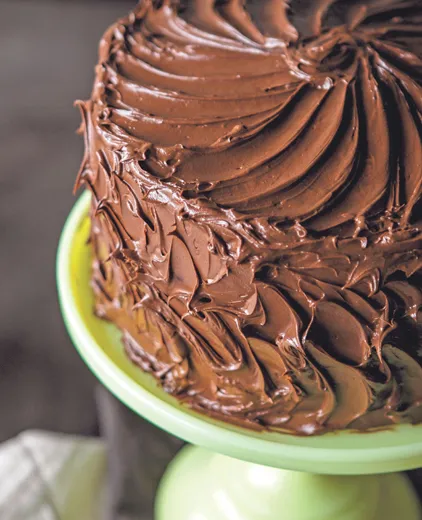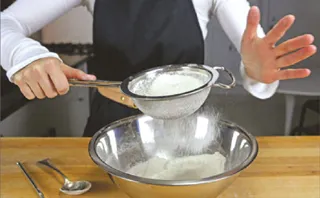![]()
CAKE & MUFFIN BLEND
The Cake & Muffin Blend combines gluten-free whole-grain flours and starches to satisfy the required characteristics for all kinds of crumbs that define the full range of cakes: from light, airy sponge cakes to dense, oil-based Bundt cakes, and every torte and gâteau in between. Traditional bakers use cake flour, which is inherently low in gluten, so you would think coming up with the perfect gluten-free blend would be a cakewalk, right? Well, for you it is. The flours used in this blend work overtime to get the baker’s ideal of perfection, or what I like to call the trifecta: taste, texture, and appearance.
THE RECIPE
Like the previous blends, the base of the cake blend is sorghum flour, ensuring that the finished baked goods taste delicious, while the starches step in to help create a tender crumb. The biggest difference you will notice about this blend is that a scant amount of potato flour is present. Potato flour helps provide excellent structure, but it also helps retain moisture, so your gluten-free cakes stay tender, longer. The density of any of the cakes you find here comes from the kinds of fats and the amount of eggs used. The lightest cakes will be held together only by egg whites and a scant amount of butter, for example, and the densest cakes will boast butter or oil, sour cream, buttermilk, and eggs, or a combination of all.
For more information on the flours, starches, and other ingredients used in the blend, see the Pantry section on this page.
MAKES 7¾ CUPS (956 G), ENOUGH FOR 3 CAKES, OR 4 BATCHES OF MUFFINS OR CUPCAKES
2½ cups plus ⅓ cup plus 1 tablespoon (320 g) sorghum flour
2½ cups plus 2 tablespoons (304 g) glutinous rice flour
½ cup plus ⅓ cup (144 g) potato starch
⅔ cup plus ½ cup plus 1 teaspoon (120 g) extra-fine brown rice flour
¼ cup plus 1 teaspoon (44 g) potato flour
8 teaspoons (24 g) guar gum
Using the spoon-and-sweep method, measure each ingredient into a large bowl. Whisk together and then sift the mixture into a separate large bowl. Repeat several times.
The approximate weight of the blend, by volume (for use in doing your own adaptations):
THE DOUGH
YOU’LL NOTICE MORE EXTRACTS
Some of the flours used in this blend have strong flavors, such as the potato and extra-fine brown rice flours. To compensate for these intense aromas, the quantities of the extracts used in the recipes are sometimes doubled, or are higher than they would be in a conventional recipe with a milder-tasting all-purpose flour.
TRY ADDING CORNSTARCH
To make even lighter cakes, and to achieve an even lighter crumb, you can add a small amount (about ¼ cup / 30 g per 2 cups / 234 g of the blend) of cornstarch to your Cake & Muffin Blend for heavenly results. Professional bakers have used this trick for years, and it works perfectly in gluten-free baking as well. The cornstarch, especially in the case of oil-based cakes, helps create larger cake crumbs, resulting in a moist yet crumbly confection.
WANNA TURN A LOAF INTO A CUPCAKE?
Remember that any of the cakes in this chapter make wonderful cupcakes. The muffins can be made into breakfast loaves, too—in either case, just be mindful of your baking time. Adjust accordingly: less time for cupcakes and more time for loaves. Start testing the cupcake or loaf after 20 minutes by inserting a toothpick or skewer into the center—if it comes out without crumbs, the baked good is done. Loaves typically take a full 30 to 45 minutes to cook all the way through.
USE PROPER MEASURING TOOLS
Most important, I do not recommend measuring your liquids in a dry measure container or cup. You will not get the amount of liquid you really need, so keep a liquid measuring cup on standby at all times.
SIFTING
Sifting loosens dry ingredients that may have become compacted in their packaging and removes any lumps; this is especially important when it comes to starches. It also helps mix different dry ingredients together. Always sift your Cake & Muffin Blend—sometimes multiple times (as in the case of the Angel Food Cake on this page). This ensures the components in the blend are evenly distributed and you don’t have rogue pockets of potato starch or guar gum wreaking havoc on your cakes.
You can sift dry ingredients through a utensil made specifically for that purpose, such as crank or canister sifters, or use a drum sieve or another fine-mesh sieve. If you’re using a sifter, measure the flour or starch into the cup of the sifter and either crank or compress the sifter handle to move the ingredient through the mesh of the sifter cup. If you’re using a sieve, hold the sieve over a bowl, measure the ingredient into the sieve, and tap the side of the sieve to pass the ingredient through the holes of the sieve.
To sift your Cake & Muffin blend, first measure the individual ingredients into a large bowl using the spoon and sweep method. Next, whisk the flours and starches to combine them. Finally, sift the mixture into a separate large bowl to further combine and scatter any remaining pockets of individual components. You can sift once or twice more, if you prefer. (There’s really no such thing as over-sifting, so sift away!)
MIXING
Recipes will often describe what the batter should look like before it gets poured into a pan rather than going solely on the amount of time you should mix a batter. If you happen to walk away from the kitchen to fold some laundry and accidentally left your butter on the counter and it became very soft, for example, it will take far less time to amalgamate your ingredients than if you used cold butter. So pay attention to the visual descriptions more than adhering to a strict mixing time.
I’ve noticed that my ingredients come together twice as fast in the summer as they do in the winter, and because my ovens are blazing most of the year, I find this interesting enough to mention. I depend heavily on my senses to tell me when something is ready in their varying stages of preparation. Sight, smell, taste, texture—all of these are barometers telling me yes, this is ready, or no, keep mixing. Take for example my classic vanilla cake, pictured below. If I am mixing the batter and it looks lumpy rather than pudding smooth, the butter has not emulsified fully and the liquids were added too soon, not giving the butter enough time to break down. This means I need to whip that batter until the friction of the paddle warms the butter enough to smooth it into the mixture.
Luckily, since this is gluten-free baking, we don’t need to worry about overmixing our ca...



